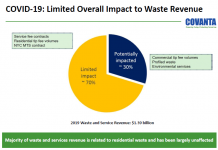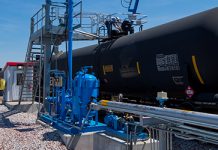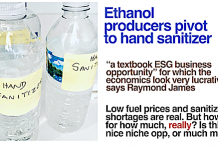Jim Lane
![coskata_small_logo[1].jpg](http://www.altenergystocks.com/wp-content/uploads/2017/08/coskata_small_logo_1_.jpg)
The first gas fermentation technology to come to the public markets: Coskata files its $100 million IPO.
Here’s our 10-minute version of the filing, with a translation of the risks into English.
In Illinois, Coskata has filed an S-1 registration statement for a proposed $100 million initial public offering. The number of shares to be offered in the proposed offering and the price range for the offering have not yet been determined. The lead book-running managers for the offering are Citigroup, Barclays and Piper Jaffray.
The company is currently ranked #17 in the world in the 50 Hottest Companies in Bioenergy. The rankings recognize innovation and achievement in fuels and are based on votes from a panel of invited international selectors, and votes from Digest subscribers.
Coskata, which in the past year lost $28.7 million while recording $250K in revenues becomes the 14th company to file for an IPO in the industrial biotech boom, which began with a successful listing on the NASDAQ by Codexis (CDXS) in 2010. IPOs by Amyris (AMRS), Gevo (GEVO), Solazyme (SZYM), and KiOR (KIOR) have followed. In recent months, PetroAlgae (PALG.PK), Bioamber, Myriant, Ceres, Genomatica, Mascoma and Elevance Renewable Sciences and Fulcrum Bioenergy have also filed S-1 registrations for proposed IPOs.
Here’s the S-1 registration, in a conveniently downsized 10-minute Digest version – with some commentary along the way as to what is driving value in the Coskata model, opportunities for the intrepid investor, and some risks which we have translated from the ancient and original SEC into modern English.
Company Overview
From the S-1: “We are a technology leader in renewable fuels and bio-based chemicals. Our low-cost, proprietary process converts a wide variety of abundant feedstocks, such as woody biomass, agricultural residues, municipal wastes, natural gas and other carbon-containing materials, into fuels and chemicals. We have combined…synthesis gas production and cleaning…with our molecular biology and process engineering capabilities to create a synthesis gas fermentation platform.
“We operated a production facility at demonstration-scale for more than two years where we achieved what we believe to be the highest yield of cellulosic ethanol per bone dry ton of feedstock demonstrated at this scale. In 2012 we expect to begin constructing our first commercial-scale cellulosic ethanol production facility.
“At our demonstration-scale facility in Madison, Pennsylvania, which we refer to as Lighthouse, we operated our technology platform to produce ethanol for over 15,000 hours. At this facility we converted a wide variety of feedstocks, including wood chips, wood waste, sorted municipal solid waste, and natural gas, into ethanol.”
The Technology
Historically, there were two widely-recognized conversion methods for the production of cellulosic ethanol: biochemical and thermochemical. The platform utilizes a hybrid process which combines key elements of the biochemical and thermochemical methods.
The process is not dependent on sugar-based feedstocks or the use of enzymes and catalysts. Our integrated platform encompasses all aspects of the production process, from feedstock handling to product separation.
The high yields and low cost are driven primarily by four factors in our production process:
• the conversion of feedstock into synthesis gas, or syngas, which makes more of the carbon in the feedstocks available for conversion;
• the use of proprietary micro-organisms that ferment syngas with a high degree of target end-product selectivity, minimizing production of less-valuable by-products;
• the elimination of chemical catalysts and enzymes; and
• the use of an integrated platform design that allows for a continuous production process.
The Market
Fuel-grade ethanol is an established fuel blendstock, representing a 23 billion gallon global market in 2010, and has drop-in compatibility with existing infrastructure. Ethanol is the most common biofuel, with the United States consuming 13 billion gallons in 2010. At a December 9, 2011 market price of $2.71 per gallon, this represents a $35 billion market.
RFS2, a U.S. government incentive program, currently mandates that 21 billion gallons of advanced biofuels be produced by 2022, with at least 16 billion gallons derived from cellulosic biofuels.
Our technology platform can also produce cost competitive chemical intermediates that can be converted into propylene and ethylene, which represented $100 billion and $140 billion global markets.
The Risks, Translated from SEC-speak
Among the lowlights of reading S-1 registrations are the endless pages of risk disclosures couched in an alloy of SECspeak and legalese.
We offer these excerpts from the original S-1, and a translation into English, prepared by our Digest lexicologists.
In SECSpeak: “In place of the plasma gasifier that we used at our Lighthouse facility, we expect to integrate an indirect biomass gasifier with our syngas cleaning technology, which have never been tested together for fuels production. While biomass gasifiers are a proven technology, they have only been used commercially on a limited basis and have experienced operational reliability issues.”
In English: Uh, we didn’t actually use our proposed gasification machine, a/k/a/ Old Unreliable, because in the demonstration that we did, we decided to demonstrate something else.
In SECSpeak: “We have entered into an MOU with a lender for $87.9 million of debt financing to fund a portion of the cost of constructing Phase I of our planned Flagship facility. We have also received a conditional commitment from the USDA relating to a 90% guarantee of such debt financing…The process for finalizing the definitive documentation with the lender and the USDA may take longer than expected or may not happen at all.”
In English: Your investment dollars may become, er, marooned (i.e “into the Valley of Death rode the six hundred”), if we don’t close this loan.
In SECSpeak: “There has been a substantial increase in ethanol production in recent years, but increases in the demand for e
thanol may be limited because of market resistance to ethanol. At current consumption levels, the industry is approaching saturation of the 10% blend level market.”
In English: And now, the Talking Heads with their classic hit, “Road to Nowhere.”
In SECSpeak: “A disruption in our supply chain for components of our proprietary nutrient package could materially disrupt or impair our ability to produce renewable fuels and chemicals.”
In English: If Rumplestilskin the Magic Coskata Microorganism doesn’t get his vitamins, he won’t spin our straw into gold.
In SECSpeak: “Our planned Flagship facility will be located in Boligee, Alabama, which is an area exposed to and affected by hurricanes. Our other future commercial production facilities may also be located in areas susceptible to natural disasters, such as hurricanes, wildfires, earthquakes and floods.”
In English: “Brownie, you are doing a heck of a job down there with Hurricane Katrina.”
In SECSpeak: “Our management team has worked together for only a limited period of time and has a limited track record of executing our business plan as a team. We have recently filled a number of positions in our senior management and finance and accounting staff. Additionally, certain key personnel have only recently assumed the duties and responsibilities they are now performing.
In English: “Brownie, if that’s your name, you are doing a heck of a job, whatever it is that you do, down there with that, what do you call it, that Flaghouse project in Alaskabama. I think. (Pause) Oh, shoot, I dialed the wrong number. How do you get an outside line here?”
In SECSpeak: “Our commercial success depends on our ability to operate without infringing the patents and proprietary rights of other parties and without breaching any agreements to which we become a party. We are aware of other parties applying various technologies, including Ineos Bio and LanzaTech NZ Ltd.”
In English: Yep, we’re aware of INEOS Bio. They are, like, suing the heck out of us.
In SECSpeak: “Although we currently intend to use the net proceeds from this offering in the manner described in “Use of Proceeds,” we will have broad discretion in the application of the net proceeds.”
In English: If we spend all this money on, say, golf memberships, the only ethanol we’ll see will be at the 19th Hole.
The Strategy
From the S-1:
“Build our first commercial-scale facility.
Expand through a flexible, capital-efficient business model.
Be a full service solution provider.
Commercialize production of bio-based chemicals.
Identify attractive global market opportunities.
Maintain technology leadership through ongoing investment in R&D.”
The Commercialization Plan
From the S-1: “Our first commercial facility will be built in Boligee, Alabama. The initial production capacity of this facility, which we refer to as Flagship, will be [Phase I] 16 million gallons of ethanol per year, and [Phase II] to achieve total production capacity of 78 million gallons of ethanol per year…at an unsubsidized cash operating cost of less than $1.50 per gallon, net of co-product sales, assuming a feedstock cost of $64 per bone dry ton of softwood.
“Phase I of Flagship will be financed by a portion of the proceeds of this offering, cash on hand and $87.9 million of debt financing supported by a 90% loan guarantee through the USDA’s 9003 Biorefinery Assistance Program.
“We expect Phase I and Phase II to be completed in 2013 and 2015, respectively.
“We expect to use a wide variety of other feedstocks, in addition to woody biomass, for subsequent facilities, including municipal solid waste, agricultural residues, energy crops and fossil fuel sources…We also believe that corn ethanol producers can expand their capacity by co-locating our technology at their existing ethanol production facilities, since it would allow them to convert agricultural residue into cellulosic ethanol.
“Our proprietary technology platform can produce valuable bio-based chemicals in addition to renewable fuels like cellulosic ethanol. We are currently collaborating with Total Petrochemicals to develop a unique micro-organism-based technology that produces propanol…coupling our propanol technology with proprietary technology to dehydrate alcohol into alkenes, including propanol into propylene.
“In addition to building and operating facilities, we plan to enter into joint ventures for the co-ownership of facilities and to license our technology platform to third parties.”
Coskata as it sees itself: 6 Competitive Strengths
Proprietary technology platform. As of November 30, 2011, we had six patents issued and 28 patent applications pending on key elements of our technology platform, including syngas cleanup, micro-organisms and continuous anaerobic fermentation. At Lighthouse, our demonstration-scale facility, [we have] over 15,000 hours of run time
Low cost production with high yields. Based on demonstration runs at Lighthouse, we expect to achieve yields of 100 gallons of ethanol per bone dry ton of softwood at Flagship, with unsubsidized cash operating costs of less than $1.50 per gallon.
Significant feedstock flexibility. Our process can utilize a wide variety of carbon-containing feedstocks, including wood chips, wood waste, municipal solid waste, agricultural residue such as corn stover and bagasse, energy crops and fossil fuel sources such as natural gas, coal and petroleum coke.
Multiple end products targeting large existing markets. Our first commercial product will be fuel-grade cellulosic ethanol. Our technology platform can also produce cost competitive chemical intermediates that can be converted into propylene and ethylene. In addition, we have demonstrated in a laboratory setting the production of butanol, butanediol, hexanol, organic acids and certain fatty acids.
Fully-integrated process solution that enables rapid commercialization. Our technology platform is a complete, fully-integrated process solution that can be delivered to our future wholly-owned facilities, as well as to our joint venture projects and licensees.
Experienced management team. We have assembled strong management, scientific and engineering teams with deep knowledge in research and development, new product development, capital project execution, feedstock procurement, plant operations and business plan execution.
Financing to date
Coskata has incurred substantial net losses since its inception, including net losses of $28.7 million for the year ended December 31, 2010 and $23.3 million for the nine months ended September 30, 2011. They expect these losses to continue for the foreseeable future. As of September 30, 2011, they had an accumulated deficit of $88.2 million.
The bottom line
The really good news here is that a sygas-to-biofuels technology is now available to investors. Of all the processing technologies, it’s been among the most promising for quite some time, but all the companies have been privately held. With syngas, you get more carbon to work wit
h, and you can work more easily with ultra-low cost feedstocks like MSW.
Even better, in maintaining their $1.50 per gallon or better projection on operating costs, Coskata is signaling that it has cracked the technology problem, from a process point of view. That’s huge.
Now, for the tough love, in five parts:
1. The USDA loan has not closed.
2. There’s no really, really significant strategic partner with skin in the game, here, whose presence says “our engineers have looked at the technology, and we believe” to the investor.
3. There’s a potentially damaging, unresolved lawsuit with INEOS Bio, how damaging, we don’t know.
4. Who knows exactly what will happen when the project switches from plasma gasification to a biomass gasifier.
5. The CAPEX looks like around $12 per gallon for the Phase I, and we’re not sure how fast that will come down in Phase II, as down it must come.
So, there are reasons why, to the retail investor, confidence may be low. If #1 and #3 are resolved and #4 and #5 are explained between the time of the filing and the road show, that will make for an easier time for CEO Bill Roe and team. As with Mascoma’s IPO, it would definitely strengthen the offering and confidence, if a major strategic came on board in a stunningly material way, as Total did with Amyris. It happened with Valero and Mascoma, and that added zing and magic to a good package.
It’s a good package that could well be a great package by the time the offer prices. Stay closely tuned to Coskata’s news stream.
The complete S-1 registration statement.
All 180-or-so pages in all their glory. The complete S-1 registration statement is here.
Jim Lane is editor and publisher of Biofuels Digest where this article was originally published. Biofuels Digest is the most widely read Biofuels daily read by 14,000+ organizations. Subscribe here.

![CoskataProcessDiagram[1].jpg](http://www.altenergystocks.com/wp-content/uploads/2017/08/CoskataProcessDiagram_1_.jpg)







